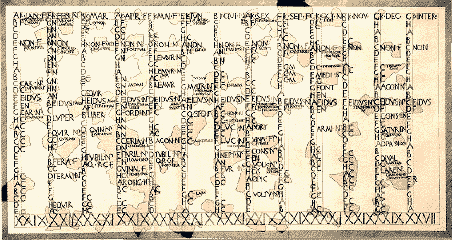 |
 |
 |
The Roman Empire
before the julian reform of 45
B.C. also had a lunar calendar.
Because it was subject to
political/religious manipulation
it was at the time abolished by
Julius Caesar. But still our
present gregorian calendar shows
the signs of the old times:
December is derived from the
roman word for ten, meaning the
tenth month. There were
originally no more than ten
lunar month's on our calendar
which began 753 years B.C. at
the Foundation of Rome (Ab Urbe
Condita) A.U.C. For today the
roman calendar indicates: At present our culture has
little or no respect for the
position of the moon and its
phases. Still we have a long
history of fighting with
cultures who managed lunar
calendars. Today we can no
longer say that they are
primitive or only religious.
Half the world swears by them
and they are just as valid as
our monthly divisions to the
sun. The fact that we corrupted
as Romans of the old days does
not mean that other cultures
would be equally corrupt.
Scientifically one can say that
the rhythm of the moon itself is
a valid reference for civil
time-management. It is the
leaping or not with a lunar
month about which the lunar
cultures themselves do not agree
that is the issue of discussion.
Such leaping according a fixed
rule stays a more or less
arbitrary form of timemanagement
and is thus either politically
or religiously colored by dogma
and valuing. This we cannot
consider here without taking
sides and betraying a possible
world order that does not
bear this kind of dissent. Therefore at
these pages the lunar order is
presented as-it-is: naked
moonphases with no delineation
of a yearcount. It is simply
an alternative way of dividing
the days on the calendar. To
the full
concept of order (see Full
Calendar of Order) which in its
scientific foundation cannot
subscribe to political and
religious arbitrariness we
have to disconsider yearcounts
to years that are not
objectively defined and
weekorders that do not align
with natural phenomena, as one
would with leaping with a day
in stead of a leaped month,
Thus the endresult is a lunar
order running right through
the logical and historically,
also on the moon founded, cakra
division of 48 weeks in a solar
tropical year. That
cakradivision (to the vedic
word cakra: disc) of a solar
tropical year is a division
that can easily be obtained
from transposing the
moonschedule of four phases in
a moon-lunation-,- see next
page- to the solar year. This
second moondivision is in
accord with as well the vedic
literature as with the
reformed roman order, the
so-called julian order, the
way it was settled by Julius
Caesar. In sum: we have a
transposed lunar calendar
and an untransposed one. The first we
call Cakra to the oldest
vedic concept of
time-management discussed at
the Order of The
Sun-pages and the
second we call Fasti to the old
roman indication of
signal-days with which the
mooncalendar originally, that
is to say before Julius
Caesar, had settled the
classical holidays of legal
and commercial arrest. The
fact that the old roman
calendar had a lot of
different calculations to
different types of management
to that one calendar does not
keep us from using that same
calendar for a new 'reformed',
that is rationalized and
counterbalanced ( by the
cakra-solar order) complete of
a better scientific respect
than we ever had before: simple
moonphases according
astronomical data, that are
and are not transposed to
the solar year. See for
further background info the
links at the bottom of the
next page. |


